
 The pleasant spring weather of Cairo supported our plan to pay a visit to the 833 years old fortress, the Salah el-Din Citadel that situated on a spur of the Muqattam Hills. It was the nerve center of the city and of Egypt.
The pleasant spring weather of Cairo supported our plan to pay a visit to the 833 years old fortress, the Salah el-Din Citadel that situated on a spur of the Muqattam Hills. It was the nerve center of the city and of Egypt.Salah el-Din Yusuf ibn Ayyub, founder of the Ayyubid dynasty in Egypt, came to power when a Crusader force threatened to attach the Fatimids, whose strength was ebbing in 1168. They appealed for help to Nur al-Din, the powerful Seljuk overlord of Damascus, who dispatched a military aid mission, of which Salah el-Din was the second in command.
 The Citadel was built on an artificially detached spur of the Muqattam range, with limestone quarried from it and large blocks supplied by the small pyramids at Giza. The first major construction work of the fortress begun by Salah el-Din in 1176 and completed in 1182. It consisted of two enclosures, the northern, and the southern. The northern half was the military area.
The Citadel was built on an artificially detached spur of the Muqattam range, with limestone quarried from it and large blocks supplied by the small pyramids at Giza. The first major construction work of the fortress begun by Salah el-Din in 1176 and completed in 1182. It consisted of two enclosures, the northern, and the southern. The northern half was the military area.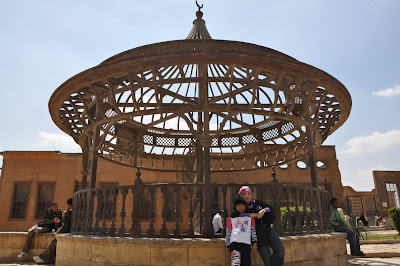 The southern half was developed by Salah el-Din’s nephew al-Kamil (1218-38) as a royal residence. However, the buildings – a mosque, an audience hall, private palaces, a library, and a mansion for the wazir – were torn down by Sultan al-Nasir Muhammad. His buildings in turn were pillaged and allowed to fall to ruin by the Ottomans, and finally demolished by Muhammad ‘Ali. There have thus been three major building periods in the Citadel’s history: twelfth-century Ayyubid, fourteenth-century Mamluk, and nineteenth-century under Muhammad ‘Ali. The two enclosures are connected by Bab al-Qulla, which stands just to the northeast of al-Nasir Muhammad’s mosque.
The southern half was developed by Salah el-Din’s nephew al-Kamil (1218-38) as a royal residence. However, the buildings – a mosque, an audience hall, private palaces, a library, and a mansion for the wazir – were torn down by Sultan al-Nasir Muhammad. His buildings in turn were pillaged and allowed to fall to ruin by the Ottomans, and finally demolished by Muhammad ‘Ali. There have thus been three major building periods in the Citadel’s history: twelfth-century Ayyubid, fourteenth-century Mamluk, and nineteenth-century under Muhammad ‘Ali. The two enclosures are connected by Bab al-Qulla, which stands just to the northeast of al-Nasir Muhammad’s mosque.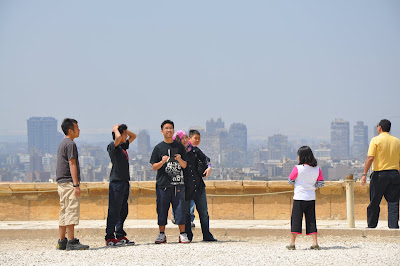 For many recent years, the Citadel was used as a military installation and much of it was not open to visitors. In 1983, however, the Egyptian Antiquities Organization initiated a widespread restoration and refurbishing program, which continues today, to make the area a major tourist center. And, now, for foreign adult visitor, you have to fork out EGP 50 and EGP 25 for children or students to enter the Citadel.
For many recent years, the Citadel was used as a military installation and much of it was not open to visitors. In 1983, however, the Egyptian Antiquities Organization initiated a widespread restoration and refurbishing program, which continues today, to make the area a major tourist center. And, now, for foreign adult visitor, you have to fork out EGP 50 and EGP 25 for children or students to enter the Citadel.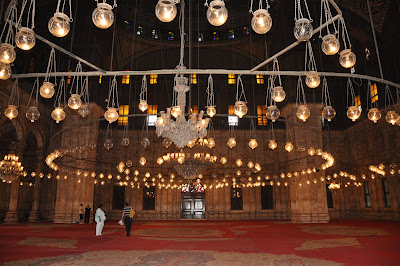 One of the prominent structures inside the fortress is the Muhammad ‘Ali’s mosque. The domes (the main one now is still under refurbishment process) and the eighty-two meters minarets of the mosque could be easily captured within 10 kilometers radius of the Citadel, are made up of the Egyptian alabaster. Muhammad ‘Ali’s chief engineer and architect, Pascal Coste, a Frenchmen, was tasked to design the original plan of the mosque in Mamluk style in 1818 until 1827. However, it was abandoned when Coste left Egypt.
One of the prominent structures inside the fortress is the Muhammad ‘Ali’s mosque. The domes (the main one now is still under refurbishment process) and the eighty-two meters minarets of the mosque could be easily captured within 10 kilometers radius of the Citadel, are made up of the Egyptian alabaster. Muhammad ‘Ali’s chief engineer and architect, Pascal Coste, a Frenchmen, was tasked to design the original plan of the mosque in Mamluk style in 1818 until 1827. However, it was abandoned when Coste left Egypt. In 1832, the construction was resumed on Coste’s foundation, but this time in an Ottoman style. Built in the Ottoman Turkish imperial style as a statement of sovereignty, its size, and dominating location make it a Cairo landmark.
In 1832, the construction was resumed on Coste’s foundation, but this time in an Ottoman style. Built in the Ottoman Turkish imperial style as a statement of sovereignty, its size, and dominating location make it a Cairo landmark.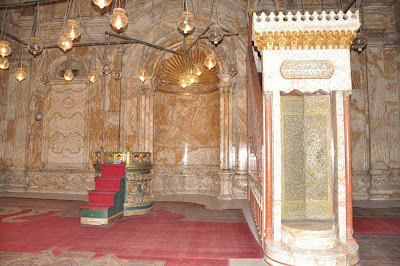 The impressive interior, which could accommodate 6,500 congregates at one time, shows the amazing arrangement of mass and space that is characteristic of the Istanbul Mosques. There are two mimbars or pulpits in the mosque. The larger one of wood decorated with gilt ornament is the original one, whereas the smaller, alabaster one was a gift from King Farouk in 1939.
The impressive interior, which could accommodate 6,500 congregates at one time, shows the amazing arrangement of mass and space that is characteristic of the Istanbul Mosques. There are two mimbars or pulpits in the mosque. The larger one of wood decorated with gilt ornament is the original one, whereas the smaller, alabaster one was a gift from King Farouk in 1939.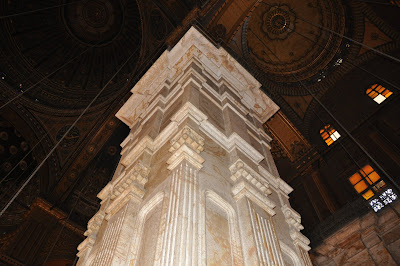 photo: one of the main white marble made pillars.
photo: one of the main white marble made pillars.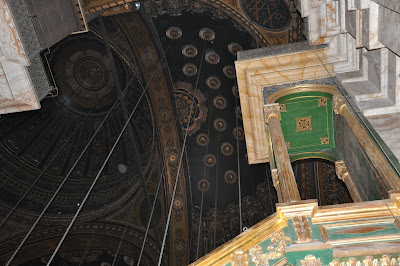 photo: the original pulprit made of wood with gilt ornament.
photo: the original pulprit made of wood with gilt ornament.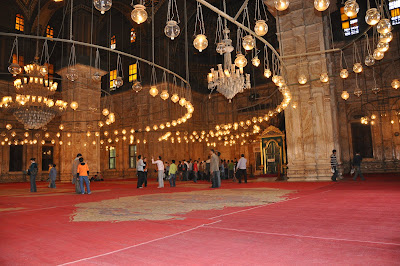 Adjacent to the Muhammad Ali’s mosque or on the southern edge of the Citadel, one could fine the Gawhara (literally menas ‘jewel’) Palace. Unfortunately, taking photos are not allowed inside the palace area. This palace, whose style is a combination of European and Turkish baroque, was where Muhammad ‘Ali waited while the Mamluks were being massacred below. It was burned in 1974, reopened in 1983 as a museum where paintings, furniture, curios, porcelain, and glass belonging to the descendants of Muhammad ‘Ali were displayed.
Adjacent to the Muhammad Ali’s mosque or on the southern edge of the Citadel, one could fine the Gawhara (literally menas ‘jewel’) Palace. Unfortunately, taking photos are not allowed inside the palace area. This palace, whose style is a combination of European and Turkish baroque, was where Muhammad ‘Ali waited while the Mamluks were being massacred below. It was burned in 1974, reopened in 1983 as a museum where paintings, furniture, curios, porcelain, and glass belonging to the descendants of Muhammad ‘Ali were displayed.On the opposite site of the Gawhara Palace and the Muhammad ‘Ali mosque, through the Bab al- ‘Alam or the gate of the flag, one can find the remnants of Sultan al-Ashraf Khalil Palace built 1292 and a Police museum. You could also quench your thirst here at the small decent cafeteria.
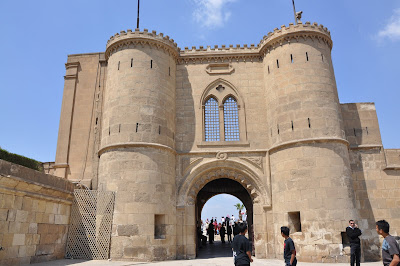 photo: the Bab al-'Alam or the gate of the Flag.
photo: the Bab al-'Alam or the gate of the Flag.After about spending forty-five minutes in the southern section, we went to the southern sector through the Bab al-Qullah, built by Sultan al-Baybars I. This section stores the Military museum, the open display area, and the mosque of Sulaiman Pasha, which is unfortunately not open to public.
 photo: on the left is the Bab al-Qullah
photo: on the left is the Bab al-Qullah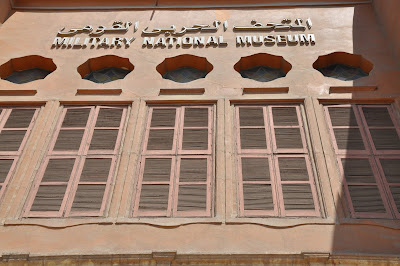
 photo: view from the Military Muzeum - the Domes of Sultan al-Nasir Muhammad and Muhammad 'Ali mosques
photo: view from the Military Muzeum - the Domes of Sultan al-Nasir Muhammad and Muhammad 'Ali mosques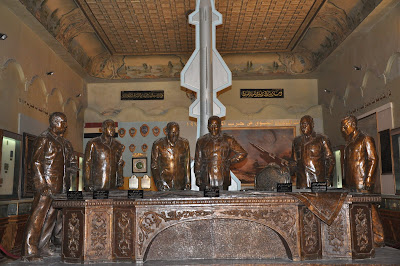




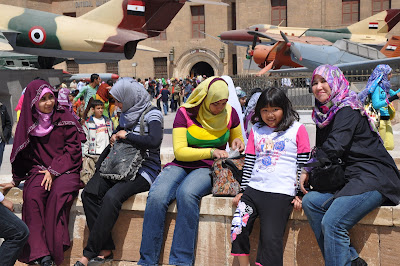
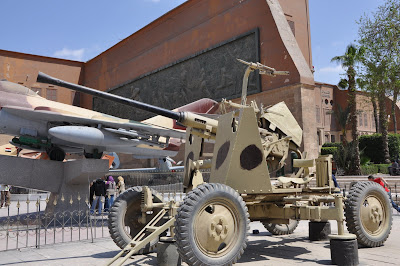
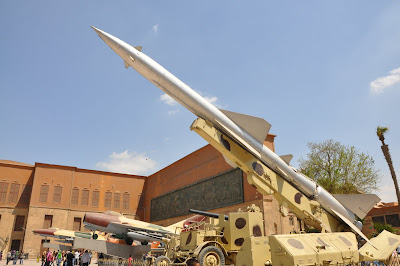
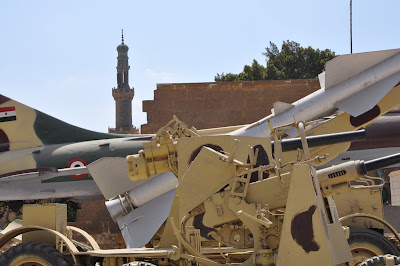

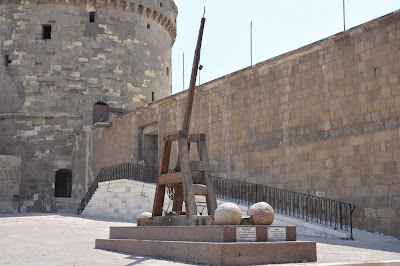
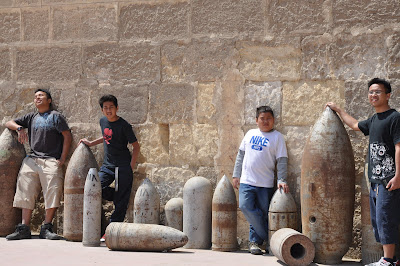 On the way out, we passed the Mosque of Sultan al-Nasir Muhammad built in 1318. The architect of this mosque was al-Mu’allim Ibn al-Suyufi. He was the court architect and is known to have been responsible for the other buildings in Cairo: the mosque of al-Maridani and the Madrasah of Agbugha, both built in 1340. Sultan al-Nasir Muhammad was the greatest builder of the Bahri Mamluk period. Except this great mosque, everything else was demolished by Muhammad ‘Ali, just as al-Nasir Muhammad himself had destroyed earlier Ayyubids’ structures.
On the way out, we passed the Mosque of Sultan al-Nasir Muhammad built in 1318. The architect of this mosque was al-Mu’allim Ibn al-Suyufi. He was the court architect and is known to have been responsible for the other buildings in Cairo: the mosque of al-Maridani and the Madrasah of Agbugha, both built in 1340. Sultan al-Nasir Muhammad was the greatest builder of the Bahri Mamluk period. Except this great mosque, everything else was demolished by Muhammad ‘Ali, just as al-Nasir Muhammad himself had destroyed earlier Ayyubids’ structures.

































